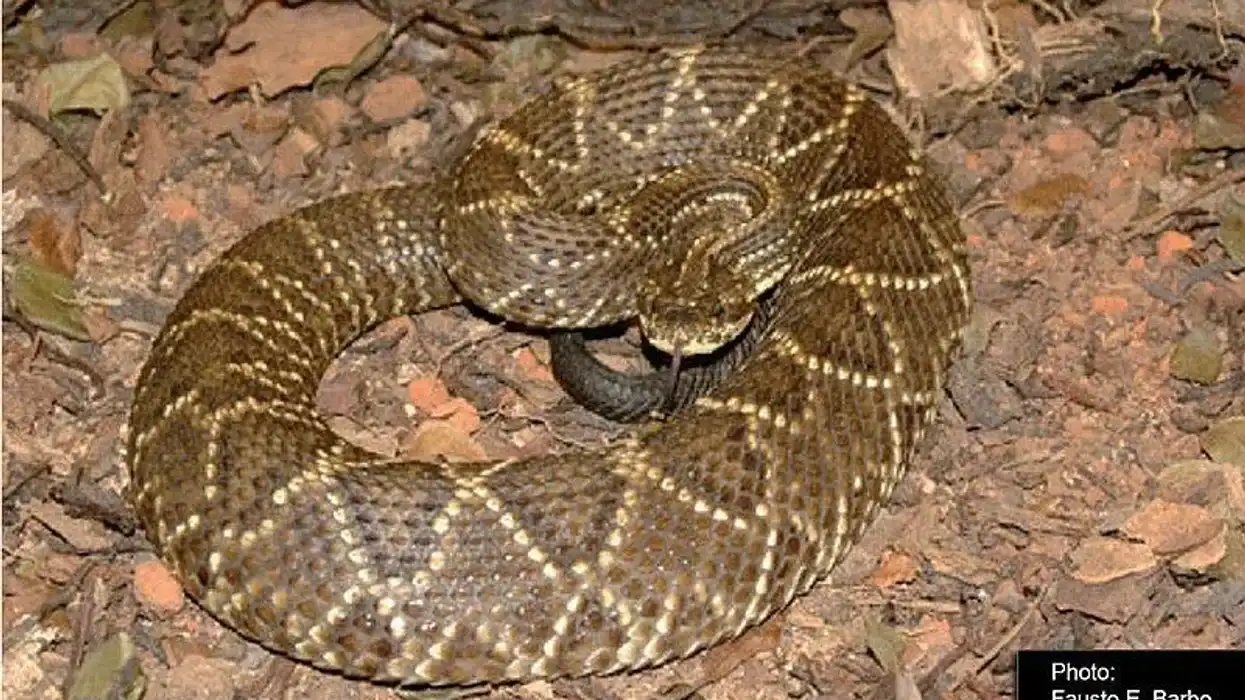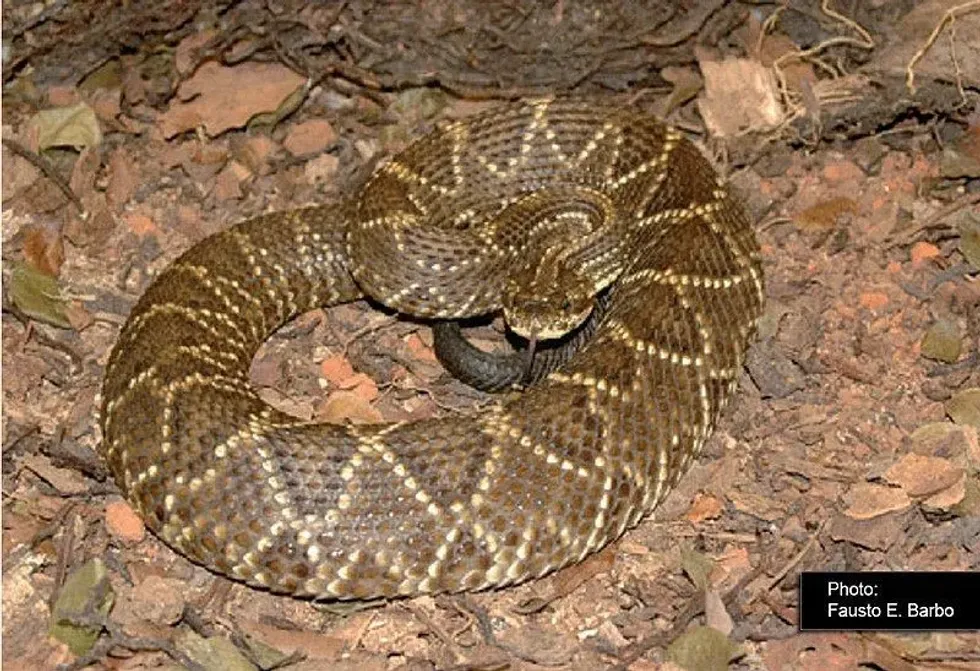Crotalus durissus (Serpentes: Viperidae: Crotalus durissus) is one of the most abundant rattlesnake species found mostly in South America. Their skin has a dark-colored scaly pattern with a rough or beaded texture.
They prey on rodents based on their special ability to sense their prey's warmth. They have sharp eyes with vertical pupils. They are highly venomous and can cause serious damage to the nervous system with just one bite.
They are mostly habituated in rocky areas, grasslands, savannas, or shrublands. They belong to the Viperidae family, and their genus is Crotalus.
Crotalus Durissus Interesting Facts
What type of animal is a Crotalus durissus?
Crotalus durissus (common name South American rattlesnake) is a highly poisonous rattlesnake. It has a unique colored pattern all over its body. It has a dark head with a gradient brown body. The colors around its tail are grayish brown.
Crotalus durissus are carnivores who prey on rodents. They are not colonized as they prefer to move alone. They have a unique feature of a rattle at the end of their tails.
What class of animal does a Crotalus durissus belong to?
American rattlesnake Crotalus durissus belongs to the class of Reptilia. This means that they are terrestrial in nature and have scales all over their body.
They are cold-blooded animals. Crotalus durissus is a reptile that sheds its skin as a skin cast since it does not fit them anymore. These rattlesnake reptiles are very venomous and use their venom to paralyze and kill their prey.
How many Crotalus durissus are there in the world?
There are about nine sub-species of Crotalus durissus terrificus left in the world. Their population is not quite discussed.
Where does a Crotalus durissus live?
Crotalus durissus live in various parts of South America. Places include the coastal savannas of Guyana, French Guiana, and Suriname.
What is a Crotalus durissus's habitat?
South American rattlesnake, Crotalus durissus, lives in various habitats such as forests, swamps, deserts, grasslands, shrublands, savannas, rocky areas, and inland cliffs. They can also swim.
Since they are cold-blooded animals, they are unable to regulate an optimized temperature, unlike warm-blooded animals. They are dependent on their environment to provide them with heat since they cannot be living in a cold atmosphere. To keep them warm in a freezing atmosphere, they hide in their dens and build swarming balls using their bodies to protect themselves.
Who do Crotalus durissus live with?
Durissus, South American rattlesnake, are solitary animals who like to live alone. They do not live in groups or packs. The only exception is when they give birth to their babies as they stay with them and look after them for a while. Once again, they become independent and move on after a certain time.
How long does a Crotalus durissus live?
South American rattlesnake ideally lives for a lifespan of 10-25 years.
How do they reproduce?
South American rattlesnake reproduces through a seasonal cycle. In the season of fall, they mate. They give birth to young ones in summer. In rattlesnakes, reproduction occurs as an ovoviviparous process, which means that the eggs hatch inside the bodies of these rattlesnakes and give birth to snakelets.
What is their conservation status?
The conservation status of Crotalus durissus is of Least Concern. This means that their existence is not at risk, and they are plentiful in number in the wild. Therefore, no steps for conservation are taken since they are not at risk.
Crotalus Durissus Fun Facts
What do Crotalus durissus look like?
Crotalus durissus terrificus is one of the most fearsome reptiles. Crotalus durissus are highly venomous with large bodies.
The shape of their head looks like a triangle. One of their unique features that makes them different and special from other snakes is their rattles at the end of their tails. Whenever the South American rattlesnake molts, it adds another layer of scales to its rattle.
This rattle is composed of many scales. There occur various muscle contractions in the scales of the rattles, making a 'rattling' sound. The size of Crotalus durissus is 4.9-6.2 ft (1.5-1.9 m).
They are dark-hued in nature with light triangular patterns mixed with dark brown shaded scales all over their body. The rattles at the end of their tails are quite light in color and have a unique shape.
South American rattlesnakes have dark vertical pupils, just like a cat. They have great vision.
They breathe through their nostrils. They do not have external ears, which can help them pick up sound waves. However, they use their close contact of the body to the ground as a medium to pick up vibrations against any movement or threat.

How cute are they?
Crotalus durissus are cute creatures based on their appearance. They have a unique patterned body which makes them look stunning. However, they are absolutely wild and shouldn't be kept in close contact or tried to be touched.
How do they communicate?
There are no specific means by which a Crotalus durissus communicates with another one of its kind. These reptiles are quite solitary in nature and roam about freely.
However, a South American rattlesnake does make sounds to express its fury. They make a hissing sound using their throat to warn other predators of their vicious attack. They also make a rattling noise as it is a part of their movement.
How big is a Crotalus durissus?
The average length of a Crotalus durissus is 4.9-6.2 ft (1.5-1.9 m). They are a little smaller than an eastern diamondback snake which is the largest rattlesnake in their family as it stands at 8 ft (2.4 m).
How fast can a Crotalus durissus move?
An average rattlesnake can move as fast as 2-3 mph (3.2-4.8 kph). They are quick to attack.
They coil up their bodies and hold their head high in a defensive position. Once predators stand in front of them, they make a hissing sound to scare them away. If not backed off, then they attack them in a quick flick by poisoning them with their venom.
How much does a Crotalus durissus weigh?
An average Crotalus durissus weighs 2.6 lb (1.2 kg). They are giant snakes with long bodies.
What are the male and female names of the species?
As of yet, there are no specific names for the male and female species of Crotalus durissus (South American rattlesnake). However, the male Crotalus durissus can be distinguished from the female one as they are bigger in size.
What would you call a baby Crotalus durissus?
A baby Crotalus durissus is called a 'snakelet'.
What do they eat?
The South American rattlesnake mostly eats rodents (rats, squirrels, murids), but they can also prey on other animals like lizards, insects, or other reptiles. Crotalus durrisus are pit vipers. They have a special feature of having pits near their eyes which helps them sense heat.
This is very helpful for them since the preying mammal's body is always warmer than the surroundings. Therefore, it helps them sense their presence even in the dark. Once they suspect an animal's presence, they attack them with their poison.
Are they poisonous?
Crotalus durissus poison is venomous. Rattlesnakes' poison is composed of hemotoxic elements. As soon as the venom enters the body, it damages the circulatory system and muscle tissues, causing severe hemorrhage and swelling. It can also damage the nervous system. One bite of this species can impair vision or even cause paralysis.
Would they make a good pet?
Crotalus durissus, a South American rattlesnake, does not qualify as a pet. They are way too dangerous. Close distance with them is highly risky. Since they are very poisonous, they can't be treated friendly. Safe distance and precautions must be taken from this wild species.
Did you know...
Native Americans used to use snake venom as an element of attack in their arrows in warfare.
Rattlesnake's rattle is made up of keratin.
Since they don't have external ears, they hear by sensing vibrations.
The eyes of Crotalus durissus have vertical pupils, just as cats.
Do Crotalus durissus bite?
Rattlesnakes do not target humans. They only survive on their hunt for rodents. They make a hissing sound, rattle their tails, and turn into a coil. If the predator does not back off, only then do they bite. However, they are wild. They can be very dangerous if mishandled or accidentally tripped on as they will surely bite.
How are they different from regular rattlesnakes?
The venom of a South American rattlesnake is very dangerous compared to other rattlesnakes. It can damage the nervous system and cause impairment to its predators or prey right away. Among all the other rattlesnakes, Crotalus durissus has the highest distribution throughout Central and South America.










